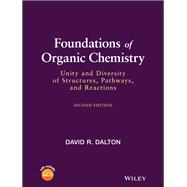Learn the fundamentals and foundations of modern organic chemistry with this comprehensive guide
Foundations of Organic Chemistry: Unity and Diversity of Structures, Pathways, and Reactions, 2nd Edition, is a substantive guide for students beginning their study of organic chemistry and instructors, as well as senior undergraduates and graduate students seeking to further their understanding of the subject.
Foundations of Organic Chemistry is a serious attempt to show students who want to learn organic chemistry how we know what we know about the subject and to guide them to learn.
In this work, the emphasis of the discussion of structures, pathways, and reactions is placed on the original literature and the fundamentals and use of spectroscopic and kinetic tools. Application of the resulting working knowledge of the substance of organic chemistry will lead the serious student to ask additional questions and, ultimately, to solve problems we face.
The book also includes solutions guides for instructors and lecturers, as well as access to a companion website for furthering the reader’s knowledge of organic chemistry.









